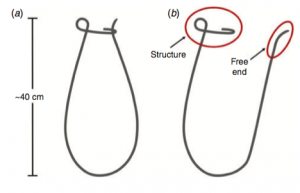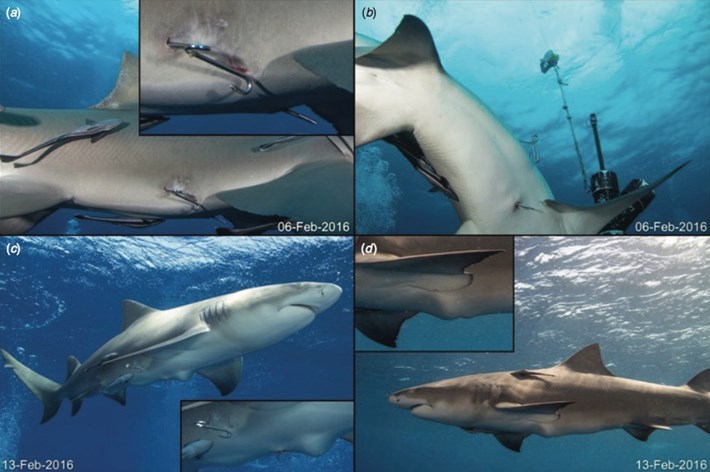
Given that sharks have been around for millions of years and can live for as long as 400 years, it is evident that the formidable species has developed an arsenal of survival mechanisms. However, a lemon shark’s two-year quest to rid itself of a piece of ingested stainless steel through its skin and self-heal Wolverine style, has impressed even the most jaded scientists.
The chain of events that led to this extraordinary discovery began in 2014. Joanne Fraser was helping with a shark feed dive operation off the coast of Florida, when she saw an adult male lemon shark with something sticking out from his right side. Having worked with marine scientists who come to Florida every winter to tag sharks, she had become accustomed to documenting anything unusual and quickly captured the strange sight with her camera.

During the next two years, Fraser, a regular at the dive site, encountered the lemon shark on several occasions. Each time, she took detailed images of what turned out to be a fish stringer — a metal loop used by spear fishermen to hang fish on a line while they continue hunting — gradually being pushed out from the shark’s right pectoral fin. Her final recorded encounter with the shark, in December 2016, was the happiest one, given that the fish had not only rid its body of the metal, but also healed entirely, with only a scar as proof of its resilience.

The section of the structure
that was protruding from the right side
of the shark, and the free end protruding
from the underbelly, are circled in red.
Image: Kessel et al./Marine and Freshwater Research
When she sent the images and video footage of the shark’s survival and extraordinary recovery to Dr. Steven Kessel and his team, they were eager to conduct a study. The Director of Marine Research at Chicago’s Shedd Aquarium says, “She (Fraser) was savvy enough to take repeated photographs and video of this individual, which let us have a very nice time series account of this shark expelling this object… something that I don’t really think has been captured before.”
The researchers, who published their findings in the journal Marine and Freshwater Research on July 13, 2017, say that since there was no entrance wound, it is highly unlikely the shark was stabbed or externally injured. They speculate that it had inadvertently swallowed the fish stringer while consuming a fishermen’s catch. "The most surprising thing for me was the sheer size of the object," says Kessel. "I have seen several sharks with fishing gear poking through their body walls, but never anything this large and never such a detailed account as our photographer and coauthor, Joanne Fraser, managed, and had the insight, to capture.
Shark species have been previously observed to expel foreign objects through stomach eversions, a voluntary process that ejects indigestible matter from their stomachs. However, Kessel says, “To my knowledge, this is the first documented account of a transcoelomic expulsion of a foreign object by an elasmobranch fish. The lemon shark’s successful removal of the fish stringer highlights the elevated level of trauma that sharks’ bodies are capable of sustaining, and draws questions about the impact of foreign objects on sharks’ post-ingestion health and survival.”

Though the shark emerged relatively unscathed from its two-year ordeal, the fish stringer, which stayed in its body for 435 days, did take a temporary toll on its health. In addition to appearing increasingly emaciated until the object had been pushed out, sometime around February 2016, the shark also had a visible bulge on its belly indicating some internal damage. The team believes it was most likely due to an injury to the liver, which occupies a large portion of the shark’s body cavity.
Researchers are not sure how sharks manage to regenerate tissue so rapidly. Dr. Bill Vann Bonn, the study’s co-author and aquatic animal medicine specialist, suspects that they may be getting some assistance from harmful microbes and bacteria that are not tolerated by land animals, but appear to reside peacefully inside sharks. The researcher believes the microorganisms may in turn be helping the fish in the self-healing process.

Since this is the first such documented case, the scientists are not sure how common the phenomenon is. But if more evidence can be collected, it might finally convince fishermen that it may be better to let an unwanted fish escape with a hook then trying to extract it. "There has been emerging evidence with fish that cutting leaders and leaving the hook in a deep/gut hooked fish, rather than digging around and trying to remove it, can result in greater survival potential," explains Kessel. The best option, of course, is to prevent these kinds of accidents caused by human carelessness from happening altogether!
Resources: Earthtouchnews.com, sheddaquarium.org, discovermagazine.com, Joanne Fraser